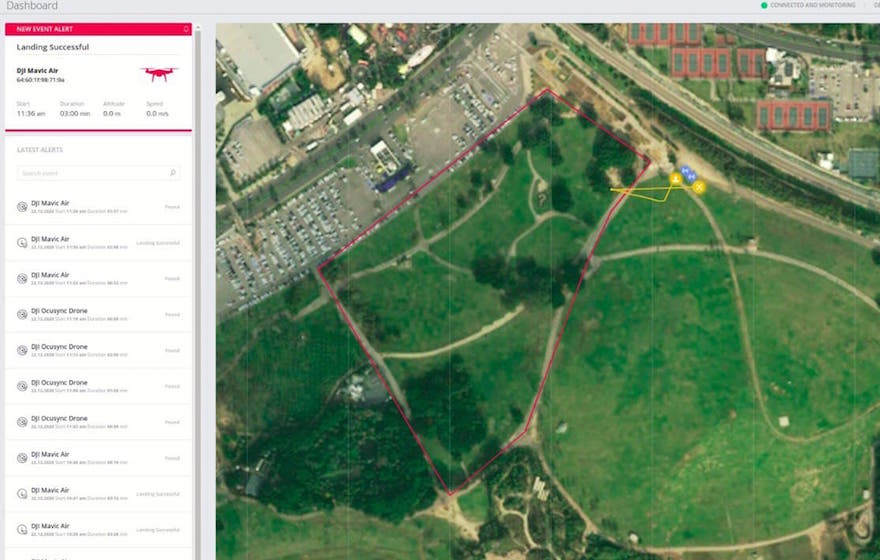Drones on construction sites and drones on completed assets: BIM+ has written a lot about drone technology and best practice in the past five years, but what happens if a drone that’s not yours flies into your project’s space? It might be an innocent mistake or it might be something much worse, indeed it might be malicious, the drone pilot intent on causing harm: what can you do?
Drone crime stats are not entirely reliable in the UK: some figures quoted by regional police forces include the theft of drones as well as the illegal use of drones. However, an FOI request of the Metropolitan Police that BIM+ found reveals there were more than 100 incidents involving drones each year in 2016, 2017 and 2018 in that force’s area.
Most infamously operations at Gatwick and Heathrow airports were seriously disrupted in separate incidents just three weeks apart at the end of 2018 and the start of 2019.
In January this year, the Mirror ran a story alleging that British military intelligence had been warned about drones being used for terrorist attacks – rather than spying, drones’ capability to carry small cargo could be used to deploy explosives or chemical weapons.
BIM+ spoke to NSO Group, a technology developer that licenses software solutions to governments and law enforcement agencies to investigate and prevent terror acts, fight crime and increase public safety.
NSO supplies a counter drone system, Eclipse, that automatically detects, takes over and safely downs unauthorised drones in a designated area with no damage to the environment or the drone itself.

There are numerous drone incidents recorded every single month and we’ve actually seen a jump in the number of cases during covid-19 in 2020.– Gilad Sahar, NSO Group
Asked about the current levels of drone crime, Gilad Sahar, business director at NSO, said: “It’s hard to give exact figures, but there are numerous drone incidents recorded every single month and we’ve actually seen a jump in the number of cases during covid-19 in 2020.
“The strangest incident was in the US in the San Francisco Bay Area when someone flew a drone over two stadiums during games, dropping leaflets promoting freedom of speech or something like that. While an amateur, he had practiced a lot to ensure the leaflets dropped in the right position given the wind speed and direction. It proved how easy it was for an amateur to fly a drone: rather than leaflets, it could have easily been something else.”
Eclipse can’t identify if an intruding drone is carrying cargo, but if safety and security comes first, this is not necessarily an issue. Sahar said: “In general, security managers say ‘if a drone shouldn’t be there, let’s take it out of the air’. Make sure it’s on the ground, then see what it is and decide what to do from there. It’s better to be safe.”
Eclipse can down the vast majority of drones, according to Sahar: “We cover the most popular drones and achieve coverage of 97% to 99%. There’s always a small trail of drones that are a bit insignificant in the market: they have less ability to cause damage, they’re small, they’re fragile, they have low battery performance, or they’re just toy drones that can’t be flown very far from the operator – they’re less of our focus.”
UK regulations effectively currently limit the use of a system such as Eclipse to the public sector, although Sahar noted that most governments worldwide are grappling with their laws, particularly around private sector operation of critical public assets.
How Eclipse works

Eclipse in action: the red line marks out the perimeter; the yellow line indicates the flight path of the intruding drone, initially flown by its pilot waywardly, and then taken over by Eclipse and flown directly to the landing zone.
Using radio frequency scanning (that doesn’t affect wifi and Bluetooth, etc), the system scans 24/7 the different frequencies used by drones.
A perimeter zone is created by the placement of a series of small, lightweight CE-approved sensors with a range of up to 4km. The zone is a dome, up to 1km high at its highest point. A site the size of Heathrow would need circa 30 sensors, Sahar said.
Once a drone is detected, the Eclipse user is alerted, with the system capturing the drone’s model and its serial number and calculating its position, altitude and speed. Once the drone enters the Eclipse perimeter, the system takes command of the drone and safely lands it in a predetermined landing area with GPS precision.
Because the system is automatic, Eclipse doesn’t require line of sight. Weather and time of day are not a factor either, Sahar said.
The person piloting the offending drone doesn’t know that Eclipse has downed it: the pilot will know only the last reported location at the moment Eclipse took the drone over.
Your own drones are ignored by the system.
Sahar said NSO needs to understand customers’ requirements fully, namely the scenarios and threats they face, to configure Eclipse appropriately for any given site. The security needs that Eclipse can address of, say, an airport are substantially different to the security needs of a prison.
Main image: 139754773 © Colicaranica | Dreamstime.com











